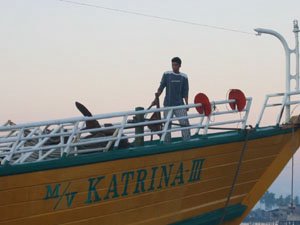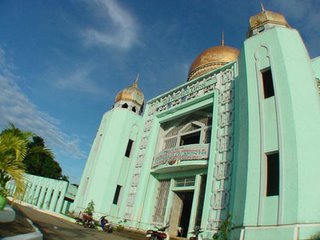Sulu's Antithesis
 What once was just an annoying topic in our social studies dawned as reality during our trip to Jolo. Zamboangeños warned us of the people in Jolo. One of them said that those from Jolo are rebels, and are not to be trusted. When my friends where in Basilan, they pretty much said the same thing about Jolo. While those we talked to from Jolo claims that it's those from Basilan that you shouldn't trust.
What once was just an annoying topic in our social studies dawned as reality during our trip to Jolo. Zamboangeños warned us of the people in Jolo. One of them said that those from Jolo are rebels, and are not to be trusted. When my friends where in Basilan, they pretty much said the same thing about Jolo. While those we talked to from Jolo claims that it's those from Basilan that you shouldn't trust.
As an outsider, one sees the age-old rivalry between the Christians and Muslims, as well as the tradition of conflict among the people. It's disheartening to witness this culture of fear and mistrust being passed on from one generation to the next. If only they could step out of their fear and anger to thrive on the natural bounty that their place offers.
***
"On that day, there was a parade in Jolo, the provincial capital, which was participated in by representatives of the province's 18 towns. It was a parade full of brilliant colors and booming sounds, extraordinary for showcasing the local culture and the diversity of natural resources that are found in the province.
The men and women came out dressed in their best traditional clothing -- colorful silks that reflected the sun -- and accoutrements such as gold jewelry and indigenous weapons. Floats representing the different municipalities were decorated with local products -- fruits such as lanzones, durian and mangosteen, which were in season at that time, and products from the sea such as crabs, lobsters, seaweeds and shells. " This is quoting from Judy Gulane's article that I found on the Web.
***
Though I studied other religions back in college, I never had a chance, until recently to be immersed in the world of Muslims. The family who took us in at Jolo city are Muslim. If not for the slight difference in their clothing, it would'nt have felt any different.
The house where we stayed at is smacked in the middle of bustling Jolo. Jolo city is just like your typical provincial town, only that it obviously looks economically deprived. However, I noticed the bling-blings that Muslim women adorned themselves with. And the fine quality of the scarves that they use to cover their heads. There's also the presence of a growing Christian community. One of the sisters of our host family is running for a leadership role for a certain board of directors. That completely shattered the image I had of Muslim women as succumbing to their men.
 The trip to Quezon beach was another surprise. Some 20-30 minutes away from the town proper is an unkempt beach which is perhaps the best kept secret of Jolo. Unfortunately, it's security that prevents travellers, even the locals, from visiting this place. Hay! Women can't even wear 'revealing' clothes at the beach so we had to settle swimming in our shirts and capri pants.
The trip to Quezon beach was another surprise. Some 20-30 minutes away from the town proper is an unkempt beach which is perhaps the best kept secret of Jolo. Unfortunately, it's security that prevents travellers, even the locals, from visiting this place. Hay! Women can't even wear 'revealing' clothes at the beach so we had to settle swimming in our shirts and capri pants.
Seeing is believing. Sulu has so much economic potential. Today's media should present a different Jolo, with its rich culture and natural bounty. It would be great to give this place a different kind of attention to help ease its tradition of conflict.
Quezon Beach: A Jolo Discovery
 I don't think I can ever gauge the amount of risk that I took when I booked a flight to Zamboanga two weeks ago.
I don't think I can ever gauge the amount of risk that I took when I booked a flight to Zamboanga two weeks ago.
Some of my palaui friends had already set plans for a Jolo-Tawi-Tawi itinerary for a week's tour. I decided to catch up with them by flying to Zamboanga with Angie last Friday then met Aryx, who just came from Davao, at the airport.
The usual ferries were closed due to Hariraya and were to resume operations on Monday. Hence, we had to scrap our day 1 itinerary and proceed with the city tour while in Zamboanga. Bamboot offered her cafe for our backpacks as we left to discover the city on our own. We had some great bargains at the Barter Trade near Canelar and spent the afternoon strolling at the Pasonanca Park and Aviary. We hit Fort Pilar after, had sati and halo-halo and eventually dozed off at the foodcourt in the local mall. The locals were quite friendly, and everyone we met were aghast and against our plan to go to Jolo that evening.
 Our friends arrived in Jolo that afternoon and we managed to get tickets for Jolo to a barge-like MV Katrina boat/ship/ferry.. well, I don't really know how to classify it. But the MV Katrina was the worse looking ship at the pier when we got there.
Our friends arrived in Jolo that afternoon and we managed to get tickets for Jolo to a barge-like MV Katrina boat/ship/ferry.. well, I don't really know how to classify it. But the MV Katrina was the worse looking ship at the pier when we got there.
The three of us hopped into the boat and settled down on our own cots. I felt out-of-place with my height and pale skin amidst the majority of Muslims and military passengers surrounding us. The warnings of our friends in Zamboanga about the trip to Jolo kept going through my head throughout our journey. Aside from the heat, everything else was ok. It's even better than our Superferry ride from Coron to Manila a coupleof months back.
At six in the morning we docked at the port of Jolo. The sight of Gio and his friend (our Muslim host) by the opening of the stairway inside the ship was a big relief. I saw the rest of the backpackers by the pier where they greeted us and escorted us to the jeep. Gio kept telling us to pipe down so as not to get too much attention as we already look foreign amidst the bustling crowd in the pier.
We got off at a small alley which led to a maze-like community of stilt houses (as in houses held by stilts set on the water). One of the doors opened to a simple yet spacious living area where we headed straight to the bedroom. That's where my friends kept their packs and it's where they slept the night before.
We were served with good coffee and some pandesal. After a while, we prepared our things for Quezon beach. The entire family of Ka Durang, his siblings, children, nephews and even their helpers accompanied us to the beach. We also had military and PNP excorts during the trip. I've yet to discover the arguments and real story behind this excursion of ours that brought quite a hassle to our host family.
Quezon beach is around 30 or so minutes from Jolo city and the site of it was just incredible. Think of it as Boracay without the clutter of tourists and commercial joints.
 It's a long stretch of powdery white sand and crystal clear sea water. The weather was perfect and the water's warm. As you go further out to sea, it remains carpeted with soft sand. I've only seen water this clean in the northern parts of Palawan, but such long stretches of fine sand I've never seen anywhere else in the country.
It's a long stretch of powdery white sand and crystal clear sea water. The weather was perfect and the water's warm. As you go further out to sea, it remains carpeted with soft sand. I've only seen water this clean in the northern parts of Palawan, but such long stretches of fine sand I've never seen anywhere else in the country.
Our ever zealous photographers took pictures right away.
Our friend Nelson, a Jolo resident, gave us enough insights on the place. This is where former president Quezon and his family took a swim during the old days and that's how it got its name.
Some twenty minutes away is Abu Sayaff territory, or so they say hence, the debate and the acquisition of military and PNP escorts during our stay. The area used to be a war zone so Jolo residents do not frequent the place. It's such a pity how this gem of a place is kept away from travellers because of security concerns.
We shared fish and some giant squids with our host family during lunch. We were back in town that afternoon, went to the kapitolyo and had another round of photo shoots.

By the end of the day, we were chance passengers in another one of those boats that ferried people from Jolo to Zamboanga. We were in a jolier mood as we were headed back to Zamboanga City, my home for the weekend.
Setting foot on Zamboanga's pier was a good feeling. Flying back to Manila even felt better.
Given the chance, I'd like to go back to Quezon beach and hopefully, security would no longer be a concern.
 What once was just an annoying topic in our social studies dawned as reality during our trip to Jolo. Zamboangeños warned us of the people in Jolo. One of them said that those from Jolo are rebels, and are not to be trusted. When my friends where in Basilan, they pretty much said the same thing about Jolo. While those we talked to from Jolo claims that it's those from Basilan that you shouldn't trust.
What once was just an annoying topic in our social studies dawned as reality during our trip to Jolo. Zamboangeños warned us of the people in Jolo. One of them said that those from Jolo are rebels, and are not to be trusted. When my friends where in Basilan, they pretty much said the same thing about Jolo. While those we talked to from Jolo claims that it's those from Basilan that you shouldn't trust. The trip to Quezon beach was another surprise. Some 20-30 minutes away from the town proper is an unkempt beach which is perhaps the best kept secret of Jolo. Unfortunately, it's security that prevents travellers, even the locals, from visiting this place. Hay! Women can't even wear 'revealing' clothes at the beach so we had to settle swimming in our shirts and capri pants.
The trip to Quezon beach was another surprise. Some 20-30 minutes away from the town proper is an unkempt beach which is perhaps the best kept secret of Jolo. Unfortunately, it's security that prevents travellers, even the locals, from visiting this place. Hay! Women can't even wear 'revealing' clothes at the beach so we had to settle swimming in our shirts and capri pants.



